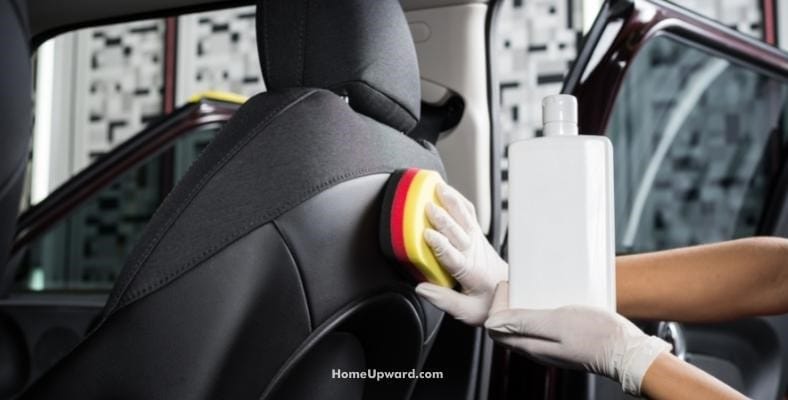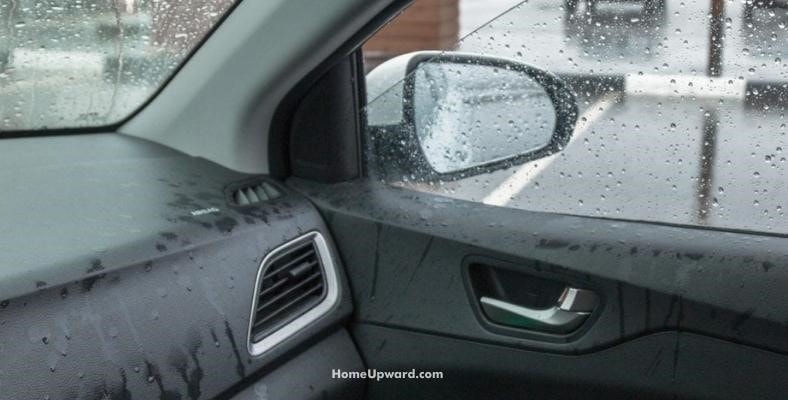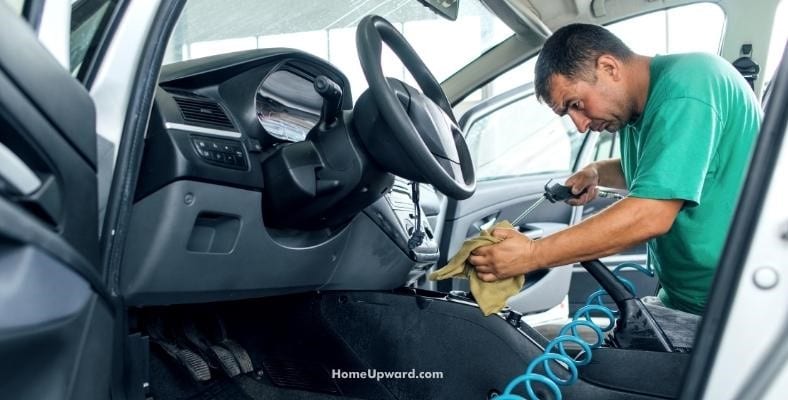Got a funky smell in your car or truck or you’ve got what may be mold or mildew growing? Don’t stress out – there are ways to deal with it!
Read on to find out how.
Contents
How To Remove Mold and Mildew From A Car Interior
What’s the Difference Between Mold and Mildew in a Car?
Both mold and mildew are fungi growths but they have some differences.
- Mold is usually black or green, has a fuzzy appearance and is the term used to refer to most fungi growths.
- Mildew is a specific type of mold or fungus and it is typically white or gray and is usually powdery.
In terms of smell, mildew has a milder smell while mold has a pungent smell (kind of like a “dank” smell). In addition, mildew thrives in relatively higher moisture areas like bathrooms while mold can grow and thrive in lower moisture areas such as leather and cloth.
In terms of your car, moisture control is the best way to avoid mold and mildew. Leaky windows and sunroofs, leaks from body gaps or wreck repair damage, or just forgetting to close your windows can lead to a build of up moisture or water that promote either one.
The good news is that once it’s there you’ve got several ways to remove it from your car’s interior.
What Kills Mold in a Car Carpet?
When it comes to mold removal from a car’s carpet, high humidity levels, spilled liquids, and flood damage are all culprits. White vinegar is mildly acidic and effective for killing mold and mildew in a car carpet.
To use vinegar:
- Mix equal parts of vinegar and water.
- Apply the mixture to moldy areas of the car carpet using a spray bottle or cloth.
- Allow the mixture to sit for several minutes before wiping it.
Ways To Get Mold and Mildew Out of a Car Interior
There are a few different ways to remove mold and mildew from your car interior.
White Vinegar Method
The white vinegar method requires mixing equal parts of white vinegar and water.
- Apply the mixture to moldy areas of your car interior using a clean cloth.
- Allow the mixture to sit for several minutes before wiping it away with a damp cloth.
Non-Iodized Salt Method
Since salt dehydrates, non-iodized salt effectively draws moisture out of mold spore membranes, killing them. Salt needs to be mixed as a solution to be effective.
To use this approach:
- Mix one tablespoon of non-iodized salt with two cups of water.
- Once mixed, apply the mixture to moldy areas of your car interior using a clean cloth.
- Allow the mixture to sit for several minutes before wiping it away with a damp cloth.
Clove Oil Solution
Clove oil is an antiseptic and can be used on the mold to reduce growth. Very little clove oil is needed; just one teaspoon of clove oil mixed with two cups of water does the trick.
- Apply the mixture to moldy areas of your car interior using a clean cloth or toothbrush.
- Once the area is dry wipe it well with a lightly damp cloth.
Baking Soda
Baking soda is more than an effective tool in the kitchen – it’s also a simple and natural way to eliminate mildew smell and clean mold from car seats and interiors.
You can use baking soda on its own by sprinkling it on the affected area. The baking soda soaks up moisture, and you can then wipe away the excess baking soda.
For a stronger solution mix the baking soda with vinegar.
Store-Bought Cleaning Solution
If you don’t want to make your mold and mildew remover you can purchase a commercial solution at your local store. Be sure to follow the instructions on the package and start with a little first.
Can I Leave Vinegar on Mold Overnight?
Yes, you can leave vinegar on mold overnight. Vinegar is a natural mold and mildew remover.
However, be sure to dilute the vinegar with water before applying it to your car interior detail. You don’t want to damage your car’s upholstery.
How Do Mold and Mildew Form Inside Your Vehicle?
Mold and mildew can form inside your vehicle for a variety of reasons. Moisture in the car is one culprit, and leather car seats are especially susceptible to mold and mildew growth.
If you live in a humid climate or don’t air out your car after driving it the moisture that’s collected over time can cause mold and mildew to form.
Another reason mold and mildew can form in your car is food or drink spills. If you spill something in your car and don’t clean it up right away mold and mildew can start to grow.
Finally, mold and mildew can also form if you have leaks in your car. Mold and mildew thrive in moist environments so proper ventilation is critical to avoid mold growth. I’ve had this problem with cars in which the sunroof leaked into the interior or water drained somehow into the cab instead of down the body and away like it should have.
Can Mold in Your Car Make You Sick?
Yes, definitely! Exposure to mold and mildew can cause respiratory health problems such as coughing and difficulty breathing. In extreme cases mold can cause more severe problems and some types are even toxic.
Some of the symptoms of mold and mildew inhalation are skin irritation, breathing issues, and headaches. If you have mold or mildew in your car don’t be lazy – it’s important to remove it as soon as possible to avoid symptoms and even worse issues.
How Do You Keep Mold From Growing Back in Your Car?
Fortunately, once you know how to remove mold and mildew from a car interior there are things you can do to keep it from coming back.
1. Keep it clean
One way is to be diligent about cleaning your car. Wipe up spills as soon as they happen and vacuum your car regularly. In addition, don’t use too many liquids while cleaning your car upholstery during car disinfection.
2. Good ventilation/allow it to dry out
Also, make sure your car is well ventilated. For example, dehumidify your vehicle if you stay in a high-humidity zone. Be sure to open your windows and doors when you can to let in the fresh air and allow any dampness to dry out.
3. Fix leaks and deal with dampness
Finally, address any car leaks. Leaks can cause mold and mildew to form especially if water is absorbed into padding under carpets or seat cushions for example.
If you’re still smelling a musky or damp scent after a few days I recommend pulling up the carpet after removing some trim to check for dampness where water may be getting in.






